I. INTRODUCTION
The discovery of superconductivity in alkali iron selenides has sparked widespread renewal interest in searching new superconductors in this class of layered compounds (Guo et al., Reference Guo, Jin, Wang, Wang, Zhu, Zhou, He and Chen2010). Lots of novel compounds have been synthesized and characterized, including the co-intercalated superconductors A x(NH3)yFe2Se2 (A = Li, Na, Ba, Sr, Ca, Yb, and Eu) (Ying et al., Reference Ying, Chen, Wang, Jin, Zhou, Lai, Zhang and Wang2012, Reference Ying, Chen, Wang, Jin, Lai, Zhou, Zhang, Shen and Wang2013), Nax(En)yFe2Se2 (Jin et al., Reference Jin, Fan, Wu, Sun, Wu, Huang, Shi, Xi, Li and Chen2017), and (Li0.8Fe0.2)OHFeSe (Lu et al., Reference Lu, Wang, Zhang, Luo, Ma, Lei, Huang and Chen2014); Cs vacancy ordered material CsFe4−δSe4 without phase separation (Li et al., Reference Li, Huang, Zhang, Xiao, Kamiya, Hosono, Yuan, Guo and Chen2018); rhombohedral and hexagonal materials LixFe7Se8 (Ying et al., Reference Ying, Gu, Chen, Wang, Jin, Zhao, Zhang and Chen2016), NaFe1.6S2 (Lai et al., Reference Lai, Chen, Jin, Wang, Zhou, Ying, Zhang, Shen and Wang2013), and CaOFeS (Jin et al., Reference Jin, Huang, Lin, Li, Wu, Ying, Wang and Chen2015); and other transition metal-based materials KMnAgSe2 (Lai et al., Reference Lai, Jin, Chen, Zhou, Ying, Zhang and Shen2014) and Ba2MO2Ag2Se2 (M = Co, Mn) (Zhou et al., Reference Zhou, Wang, Jin, Li, Lai, Ying, Zhang, Shen, Wang and Chen2014) as well. Similar to the case of cuprates (Chen et al., Reference Chen, Liang, Xie, Qiao, Tong and Xing1992, Reference Chen, Liang, Tang, Wang and Rao1995a, Reference Chen, Liang, Wang, Wu and Raoc; Tu et al., Reference Tu, Chen, Ma, Zhao, Xu, Hu and Liang2001), iron-based superconductors have a close relation with the suppression of magnetic long-range ordering by carrier doping, orbital hybridization, external pressures, and chemical pressures. Geometrical frustration, a phenomenon arising from the competing magnetic interactions that cannot all favor a same ordered state because of local geometric constraints, exhibits no magnetic long-range ordering. It is expected to play a role in inducing superconductivity by suppressing antiferromagnetism and might have a connection with new unconventional superconductors (Anderson, Reference Anderson1987; Collins and Petrenko, Reference Collins and Petrenko1997).
As the simplest form of a geometrically frustrated lattice in two dimensions, the triangular lattice with an antiferromagnetic coupling single magnetic atom per unit cell has been extensively studied for searching spin-disordered states ever since a quantum spin-disordered state was first proposed by Anderson (Anderson, Reference Anderson1973). Up to now, only a few triangular lattice antiferromagnets have been reported to be a spin-disordered state, such as the organic materials κ-(BEDT-TTF)2Cu2(CN)3 (Shimizu et al., Reference Shimizu, Miyagawa, Kanoda, Maesato and Saito2003), EtMe3Sb[Pd(mit)2]2 (Itou et al., Reference Itou, Oyamada, Maegawa, Tamura and Kato2008), and inorganic materials NiGa2S4 (Nakatsuji et al., Reference Nakatsuji, Nambu, Tonomura, Sakai, Jonas, Broholm, Tsunetsugu, Qiu and Maeno2005), FeGa2S4 (Nakatsuji et al., Reference Nakatsuji, Tonomura, Onuma, Nambu, Sakai, Maeno, Macaluso and Chan2007), and FeAl2Se4 (Li et al., Reference Li, Jin, Guo, Xu, Su, Feng, Liu, Zhou, Ying, Li, Wang and Chensubmitted). NiGa2S4 is the first example of a low-spin (S = 1) antiferromagnet with one Ni atom site on each triangular lattice point. Two triangular lattice antiferromagnets NaxCoO2·yH2O (Takada et al., Reference Takada, Sakurai, Takayama-Muromachi, Izumi, Dilanian and Sasaki2003) and κ-(BEDT-TTF)2Cu2(CN)3 (Kurosaki et al., Reference Kurosaki, Shimizu, Miyagawa, Kanoda and Saito2005) have been reported to possess superconductivity through doping or pressure.
Here we report the synthesis and characterization of two quasi-two-dimensional (2D) triangular antiferromagnetic materials Co0.66Al2Se3.53 and Ni0.61Al2Se3.55 with S = 3/2 and 1, respectively. Our results suggest that Co0.66Al2Se3.53 and Ni0.61Al2Se3.55 are highly frustrated magnetic materials that are isostructural with FeAl2Se4. Co0.66Al2Se3.53 possesses an effective moment of 4.92 µ B with a high frustration index of 48. AC susceptibility and X-ray photoelectron spectroscopy (XPS) measurements suggest a spin glass-like transition, which is not induced by intersite mixing disorder. On the other hand, Ni0.61Al2Se3.55 possesses an effective moment of 2.38 µ B, a Curie–Weiss temperature of −62 K with no sign of spin-freezing transition down to 2 K. The stronger magnetic frustration in the case of Co0.66Al2Se3.53 and Ni0.61Al2Se3.55 should originate from the relatively small spin of 3/2 and 1 for Co0.66Al2Se3.53 and Ni0.61Al2Se3.55, respectively.
II. EXPERIMENTAL
Polycrystalline samples of Co0.7Al2Se3.7 and NiAl2Se3.7 were prepared via conventional solid-state method using Co powder, Ni powder, Al wire, and Se shot (Alfa, 99.999, 99.999, 99.9, and 99.999%, respectively) as starting materials. Al2Se3 precursors were prepared via the reaction of Al wire and Se shot at 1150 K for 24 h in sealed quartz tubes. CoSe and NiSe precursors were prepared via the reaction of Co/Ni powder and Se powder at 1150 K for 24 h in sealed quartz tubes. The obtained Al2Se3 precursors together with stoichiometric amount of CoSe/NiSe precursors were pulverized, pressed into a pellet, sealed in a quartz tube with Ar gas, and then heated and kept at 1073 K for 72 h. The obtained polycrystalline samples were black and air-sensitive. Because of the sensitivity to air and moisture of raw materials, all operations were performed in an argon-filled glove box.
Room temperature powder X-ray diffraction (PXRD) data were collected using a PANalytical X'Pert PRO diffractometer (CuKα radiation) with a graphite monochromator in a reflection mode from 2θ = 10° to 130° and step = 0.017° (Chen et al., Reference Chen, Liang and Wang1995b). Rietveld refinements were performed with the FULLPROF package (Rodriguez-Carvajal, Reference Rodriguez-Carvajal2001). The magnetic susceptibilities were measured using a vibrating sample magnetometer (VSM, Quantum Design). AC magnetizations were measured on a Magnetic Properties Measurement System (MPMS, Quantum Design). The XPS measurements were performed with an ESCALAB Mk II (Vacuum Generators) spectrometer using AlKα X-rays (240 W). The binding energies were calibrated against the C 1s signal (284.8 eV) of adventitious carbon.
III. RESULTS AND DISCUSSION
Figure 1(a) and (b) show the PXRD patterns of polycrystalline Co0.7Al2Se3.7 and NiAl2Se3.7 sample collected at room temperature, respectively. The reflection peaks could be indexed with a trigonal symmetry with lattice parameters a = 3.8089(1) Å, c = 12.676(1) Å for Co0.7Al2Se3.7 and a = 3.7880(1) Å, c = 12.650(1) Å for NiAl2Se3.7, respectively. According to the extinction conditions, the possible space group is P-3m1(No. 164), which is isostructural with the previously reported compound FeAl2Se4. Adopting the possible space group P-3m1, the indexed values of 2θ obs, 2θ cal, Δ2θ, d obs, d cal, I obs, and (hkl) are listed in Supplementary materials with the figures of merit F(30) = 68.7(0.007, 72) for Co0.7Al2Se3.7 and F(30) = 91.2(0.0041, 83) for NiAl2Se3.7, respectively. Compared with the reported lattice parameters a = 3.8335(1) Å, c = 12.737(1) Å in FeAl2Se4, the lattice parameter a of Co0.7Al2Se3.7 and NiAl2Se3.7 shrinks by 0.64 and 1.19%, while c shrinks by 0.48 and 0.68%, respectively. The evolution of lattice parameters is reasonable, considering the gradual decrease of ionic radius for Fe2+, Co2+, and Ni2+. Rietveld refinements against the PXRD data were performed by adopting the FeAl2Se4 structure as an initial model. Considering the volatility of Se and the reported isostructural compound Ni0.7Al2S3.7, we set occupancy of Al atom to be 1 (Higo et al., Reference Higo, Ishii, Menard, Chan, Yamaguchi, Hagiwara and Nakatsuji2011). The refinements smoothly converged to R p = 4.22%, R wp = 6.19%, R exp = 2.41% for Co0.7Al2Se3.7 and R p = 2.99%, R wp = 4.36%, R exp = 2.67% for NiAl2Se3.7, respectively. The sample compositions determined from the refinement are Co0.66Al2Se3.53 and Ni0.61Al2Se3.55, respectively, which are used in the text hereafter. We calculate the theoretical density of both samples, which are 3.86 and 3.91 g cm−3 for Co0.66Al2Se3.53 and Ni0.61Al2Se3.55, respectively. The composition of Co0.7Al2Se3.7 was checked by inductively coupled plasma atomic emission spectrometer, giving an atomic ratio of Co0.69Al2Se3.61, consistent with our Rietveld refinements. The reason for the large quantity of vacancies in the proposed structure is not quite clear. But based on previous reports, NiGa2S4 is full occupancy while Ni0.7Al2S3.7 possesses a large quantity of vacancies. Since atom radius is crucial for holding a structure, we can infer that the small atom radius of Al compared with Ga might be responsible for this phenomenon. Detailed structural parameters are listed in Table I. As shown in Figure 1(c), the compound is built by stacking of layers consisting of edge-sharing CoSe6/NiSe6 octahedra connected by a top and a bottom sheet of AlSe4 tetrahedra. The layer spacing is separated with each other by a van der Waals gap. Figure 1(d) and (e) shows the central CoSe6/NiSe6 octahedra layer viewed along the [001] and [100] direction. The Co/Ni ions form a triangular lattice plane, which is isostructural to the CoO2 layer of the known superconductor NaxCoO2·yH2O. The CoSe6/NiSe6 octahedra probably gives Co2+ and Ni2+ a ![]() $t_{{\rm 2g}}^{\rm 4} e_{\rm g}^{\rm 2} $ configuration with a high spin S = 3/2 and 1, respectively (Nakatsuji et al., Reference Nakatsuji, Tonomura, Onuma, Nambu, Sakai, Maeno, Macaluso and Chan2007).
$t_{{\rm 2g}}^{\rm 4} e_{\rm g}^{\rm 2} $ configuration with a high spin S = 3/2 and 1, respectively (Nakatsuji et al., Reference Nakatsuji, Tonomura, Onuma, Nambu, Sakai, Maeno, Macaluso and Chan2007).
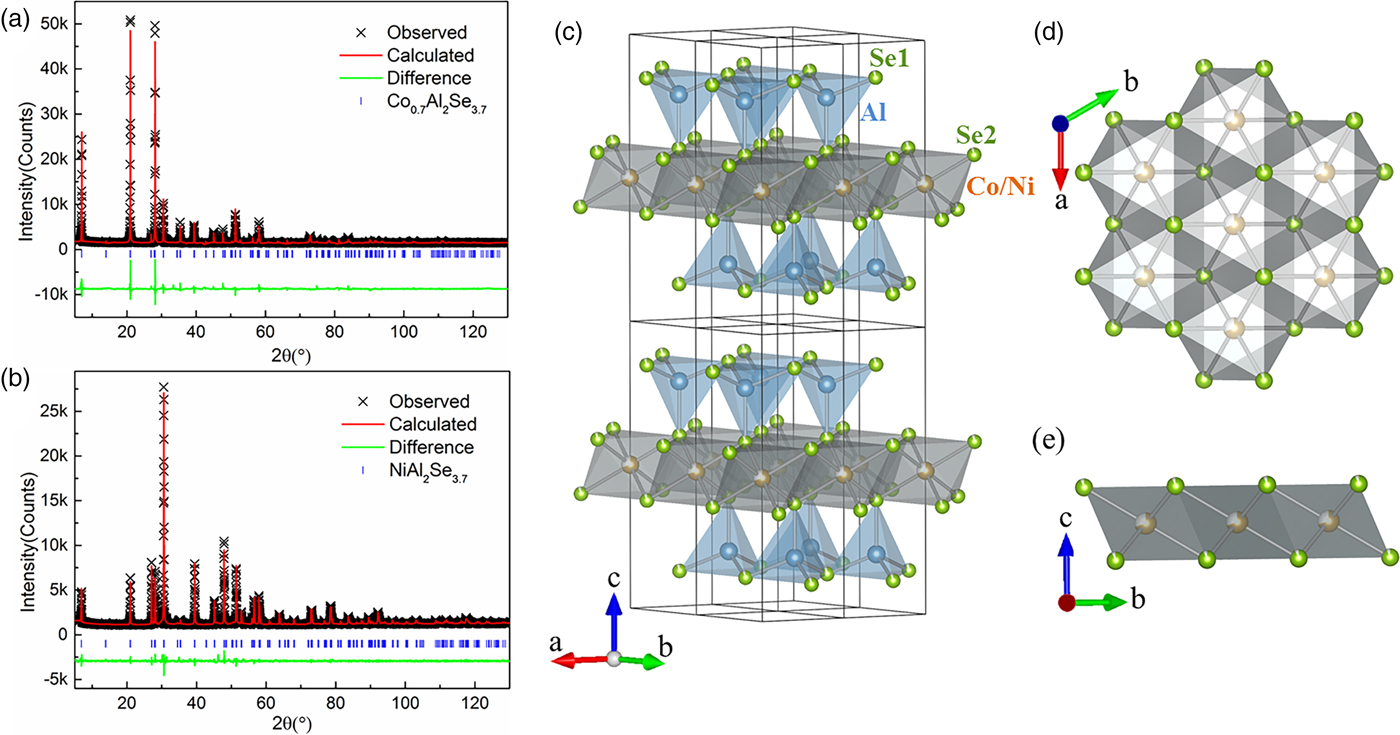
Figure 1. (Color online) (a)–(b) Powder X-ray diffractions and Rietveld refinements of Co0.7Al2Se3.7 and NiAl2Se3.7 at room temperature, respectively. (c) The schematic crystal structure of Co0.7Al2Se3.7/NiAl2Se3.7. (d) The crystal structure of CoSe6/NiSe6 octahedral layer viewed along [001] direction. (e) The crystal structure of CoSe6/NiSe6 octahedral layer viewed along [100] direction.
Table I. Room temperature structure details of Co0.66Al2Se3.53 and Ni0.61Al2Se3.55.
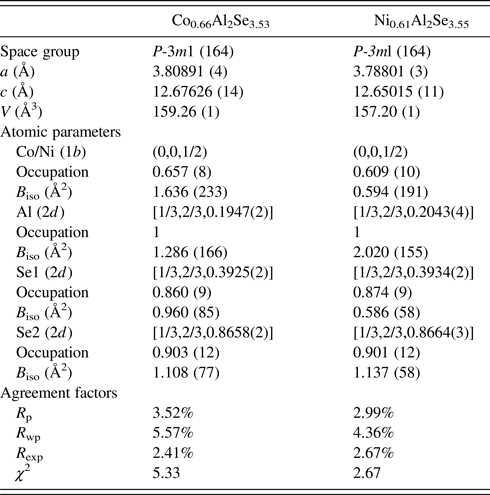
Figure 2(a) shows the temperature-dependent DC magnetic susceptibility χ and its inverse χ −1 under applied fields of 0.01, 1, and 8 T for Co0.66Al2Se3.53. A bifurcation (denoted as T f) at 4.5 K can be seen under 0.01 T for Co0.66Al2Se3.53, which is suppressed when the applied field reaches 1 T. This transition is probably associated with a spin-freezing transition (Mydosh and Ebrary, Reference Mydosh and Ebrary1993). The temperature-dependent susceptibility from 100 to 300 K obeys the Curie–Weiss law χ = C/(T − θ cw), where C is the Curie constant and θ cw the Weiss temperature as illustrated in the inset of Figure 2(a). An effective moment of 4.92 µ B was obtained from the fitted Curie constant. The Weiss temperature θ cw = −216 K indicates strong antiferromagnetic interactions. The frustration index, defined by f = −θ cw/T f, is estimated as 48, which is a relatively large value compared with FeAl2Se4 (Li et al., Reference Li, Jin, Guo, Xu, Su, Feng, Liu, Zhou, Ying, Li, Wang and Chenunpublished). Thus, we conclude that Co0.66Al2Se3.53 is a highly magnetically frustrated system. Figure 2(b) shows the temperature-dependent DC magnetic susceptibility χ and its inverse χ −1 for Ni0.61Al2Se3.55. Unlike FeAl2Se4 and Co0.66Al2Se3.53, no bifurcation down to 2 K can be seen under a field of 0.01 T. However, fitting the temperature-dependent susceptibility from 100 to 300 K with the Curie–Weiss law gives an effective moment of 2.38 µ B and Weiss temperature θ cw of −62 K, indicating a strong magnetically frustrated system.
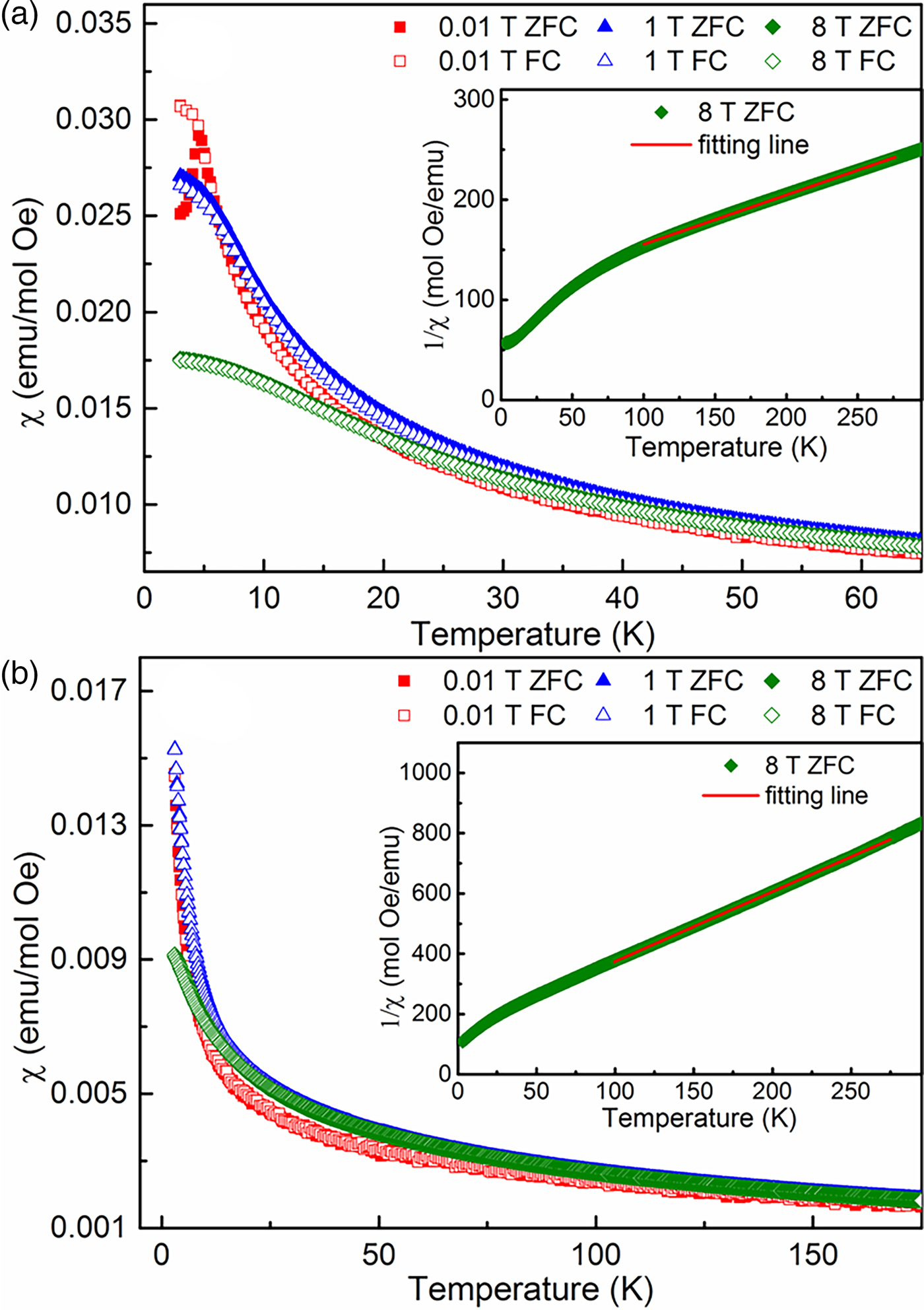
Figure 2. (Color online) (a)–(b) Zero-field-cold (ZFC) and field-cold (FC) χ(T) data taken under different applied fields from 2 to 300 K for Co0.66Al2Se3.53 and Ni0.61Al2Se3.55, respectively. Inset: the inversed χ −1(T) data with an applied field of 8 T. The solid red lines are linear fits with a Curie–Weiss law χ = C/(T − θ cw).
To characterize the magnetism of Co0.66Al2Se3.53 at temperatures near the bifurcation, we measured its temperature-dependent AC susceptibility from 2 to 10 K at different frequencies. As shown in Figure 3, a peak at about 4.5 K is observed in the real part, which is the signature of the susceptibility bifurcation. A small but clear peak shift towards high temperatures can be seen as increasing frequency, which suggests a spin relaxation behavior. The shift of the peak temperature as a function of frequency described by the expression, (ΔT f)/(T fΔlogω), can be used to distinguish spin glass and spin glass-like materials (Mydosh and Ebrary, Reference Mydosh and Ebrary1993; Krizan and Cava, Reference Krizan and Cava2014). The value obtained for Co0.66Al2Se3.53 is 0.038, which is slightly larger than expected for a canonical spin glass but is in the range of spin glass-like materials. The Volger–Fulcher law is then applied to characterize the relaxation feature with a function correlating the bifurcation temperature (T f) and frequency (f): T f = T0 − (E a)/(k B)1/ln(τ 0f), where τ 0 is the intrinsic relaxation time, E a the activation energy of the process, and T 0 the ideal glass temperature (Mydosh and Ebrary, Reference Mydosh and Ebrary1993). Fixing the ideal glass temperature T 0 = 4.5 K, the obtained relaxation time τ 0 is 5.4 × 10−10 s, and the activation energy E a is 0.14 meV. It should be noted that the small peak at approximately 7 K originates from the instrument error.
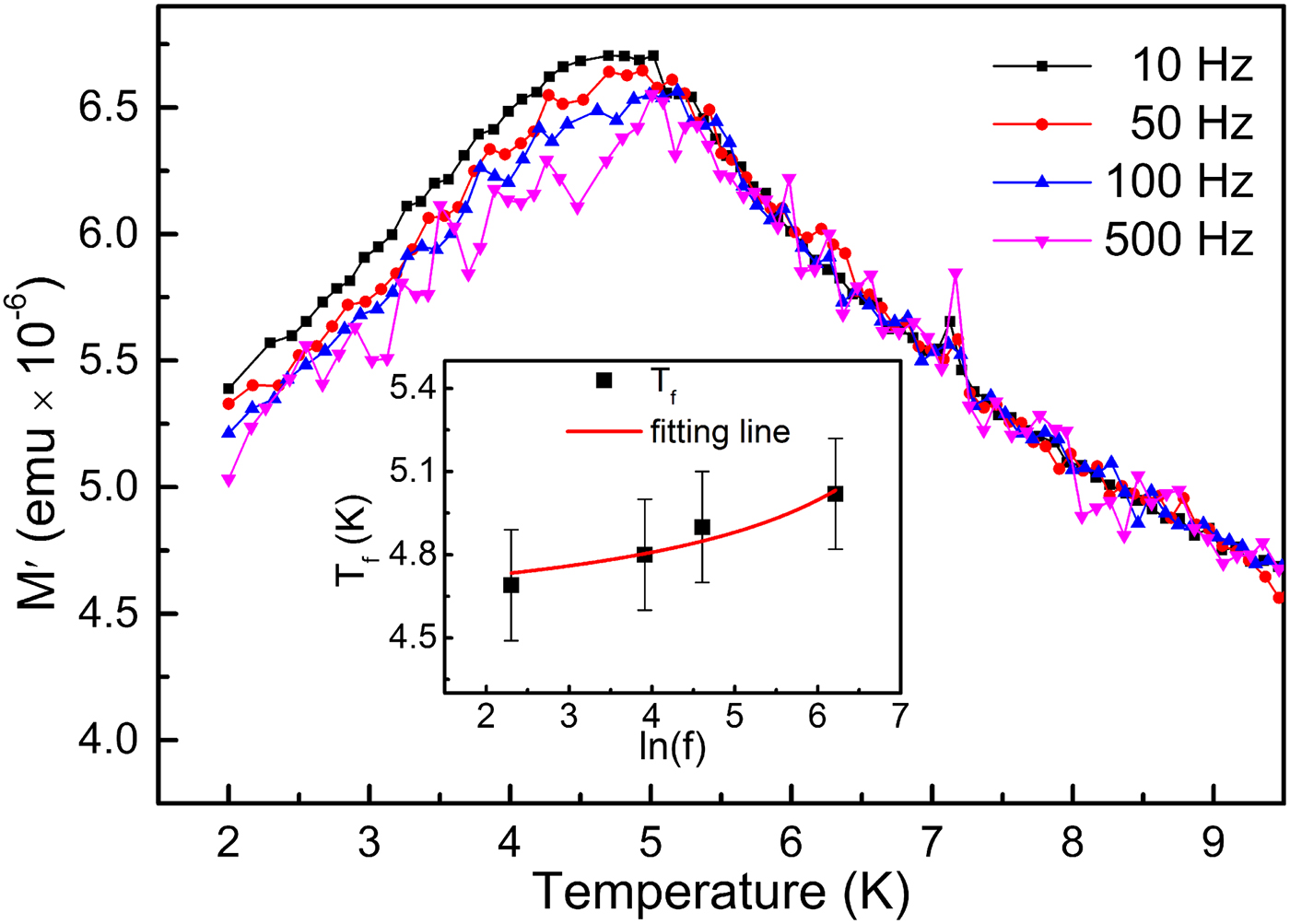
Figure 3. (Color online) Temperature dependence of the real part of the AC magnetic susceptibilities as a function of frequency for Co0.66Al2Se3.53 sample. Inset shows the parameterization of the spin freezing (as determined by the AC susceptibility) and fitting line to the Volgel–Fulcher law.
Spin glass transition usually originates from atom disorder in the compounds; thus, XPS measurements were carried out to check the intersite mixing between Co2+ and Al3+. Figure 4(a) shows Co 2p spectra of the Co0.66Al2Se3.53 samples. Because of the spin–orbit coupling, the Co 2p spectra were split into two different parts: Co 2p 3/2 and Co 2p 1/2, the fitted binding energy values are 793.6 and 778.6 eV. The full width at half maxim (FWHM) of the peak of Co 2p 1/2 is 1.21. Figure 4(b) shows Al 2s spectra of the Co0.66Al2Se3.53 samples. The fitted binding energy value is 119.8 eV with FWHM of 1.71, corresponding to that of the previously reported Co2+ and Al3+ oxidation states (McGuire et al., Reference McGuire, Schweitzer and Carlson1973; Mandale et al., Reference Mandale, Badrinarayanan, Date and Sinha1984). No sign of widening and unsymmetrical can be observed from the peak shape, indicating there is no sign of intersite mixing between Co2+ and Al3+ (Zha et al., Reference Zha, Zhou, Zhao and Feng2016). Thus, the observed spin glass transition should not originate from the intersite mixing disorder between Co2+ and Al3+ ions.
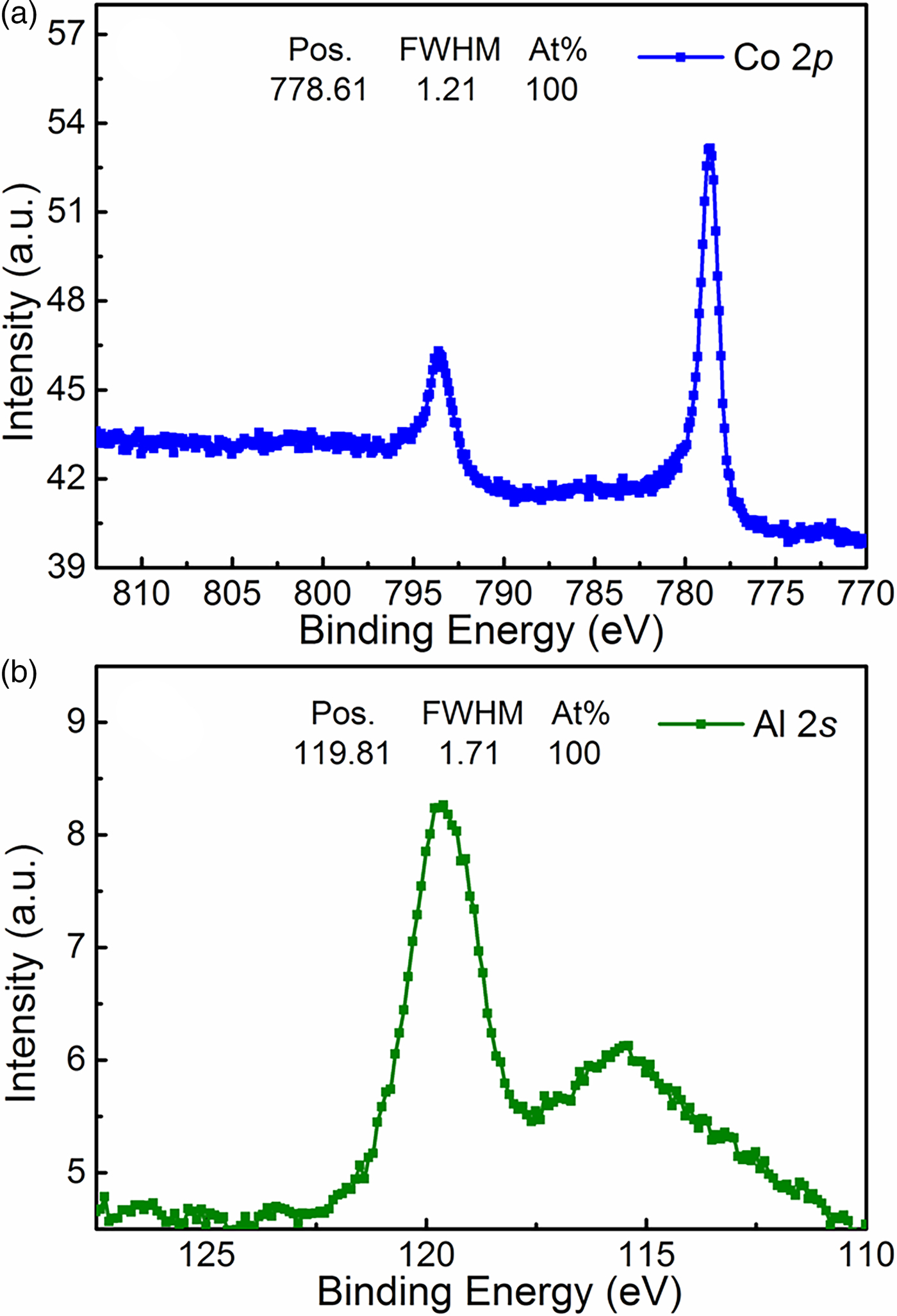
Figure 4. (Color online) XPS spectra of Co0.66Al2Se3.53 sample for Co 2p (a) and Al 2s (b).
The reported isostructural FeAl2Se4 compound possesses a spin-freezing transition at T f = 14 K with a frustration index of 14. For Co0.66Al2Se3.53 samples, although there is no intersite mixing between Co2+ and Al3+, susceptibility measurements yield a spin-freezing transition at T f = 4.5 K with a frustration index of 48, nearly three times larger than that in FeAl2Se4 compound. In the case of Ni0.61Al2Se3.55 samples, no sign of spin-freezing transition can be observed down to 2 K with a Weiss temperature θ cw of −62 K. As Collins and Petrenko showed, magnetic frustration would occur in a 2D triangular lattice, if no disturbance occurs from other sources such as interlayer coupling or magnetic impurities (Collins and Petrenko, Reference Collins and Petrenko1997). In our case, the stoichiometric FeAl2Se4 shows spin-freezing transition, while Ni0.61Al2Se3.55 shows no sign of spin-freezing transition with vacancies. Thus, we can speculate that vacancies might not be crucial for magnetic properties and its impact on these three materials needs further investigation. Moreover, the fluctuations of the spins in a spin liquid can be classical or quantum. For systems with large S, classical spin fluctuations dominate and are driven by thermal activation energy. Spins can be thought of as reorienting randomly with time, cycling through different microstates. When the energy k BT becomes too small, classical fluctuations cease and the spins either freeze or order (Balents, Reference Balents2010). With S being comparable to 1/2, energy change because of the spin flips is relatively small. Entangled spin pairs will remain to have a considerable lifetime. The fluctuations because of the spin flips will result in a large number of states with the same energy, i.e. the quantum spin liquid, which can persist down to T = 0 K. Thus, a transition from spin liquid to spin glass is possible when the spin changes from S = 1/2 in Lu2Mo2O5N2 to S = 1 Lu2Mo2O7 (Clark et al., Reference Clark, Nilsen, Kermarrec, Ehlers, Knight, Harrison, Attfield and Gaulin2014). Therefore, it can be understood that the magnetic frustration becomes stronger from the case of FeAl2Se4 to Co0.66Al2Se3.53 and Ni0.61Al2Se3.55.
IV. CONCLUSION
In conclusion, we discover two quasi-2D triangular antiferromagnetic materials Co0.66Al2Se3.53 and Ni0.61Al2Se3.55 for the first time. Our results suggest that Co0.66Al2Se3.53 and Ni0.61Al2Se3.55 are highly frustrated magnetic materials. The susceptibility data analyses reveal an effective moment for the Co2+ of 4.92 µ B, a high Curie–Weiss temperature of −216 K and a spin-freezing transition of 4.5 K in Co0.66Al2Se3.53, which gives a frustration index f = −θ cw/T f ≈ 48. Ni0.61Al2Se3.55 possesses an effective moment of 2.38 µ B and a Curie–Weiss temperature of −62 K, with no sign of spin-freezing transition down to 2 K. The AC susceptibility data of Co0.66Al2Se3.53 suggest a glass-like transition, but no intersite mixing between Co2+ and Al3+ was observed from the XPS measurements, indicating the observed spin-freezing transition should not be induced by intersite mixing disorder. The strong magnetic frustration in Co0.66Al2Se3.53 and Ni0.61Al2Se3.55 should originate from the relatively small spin of Co0.66Al2Se3.53 and Ni0.61Al2Se3.55.
SUPPLEMENTARY MATERIAL
The supplementary material for this article can be found at https://doi.org/10.1017/S0885715618000507.
DISCLOSURES
The authors declare no competing financial interests.
ACKNOWLEDGEMENTS
This work was supported by the National Natural Science Foundation of China (Grant No. 51772322), Starting-up for 100 talent of Chinese Academy of Sciences and the National Key Research and Development Program of China through Contract Nos. 2016YFA0300600 and 2017YFA0304700.








